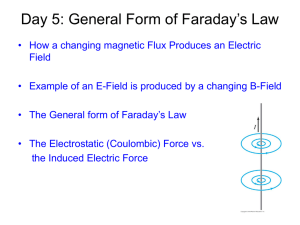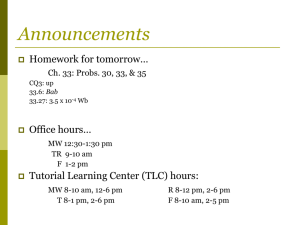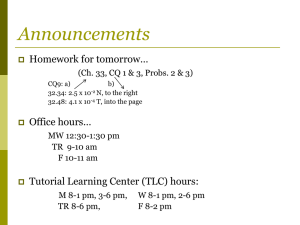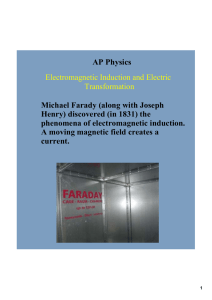Time-Varying Fields
advertisement
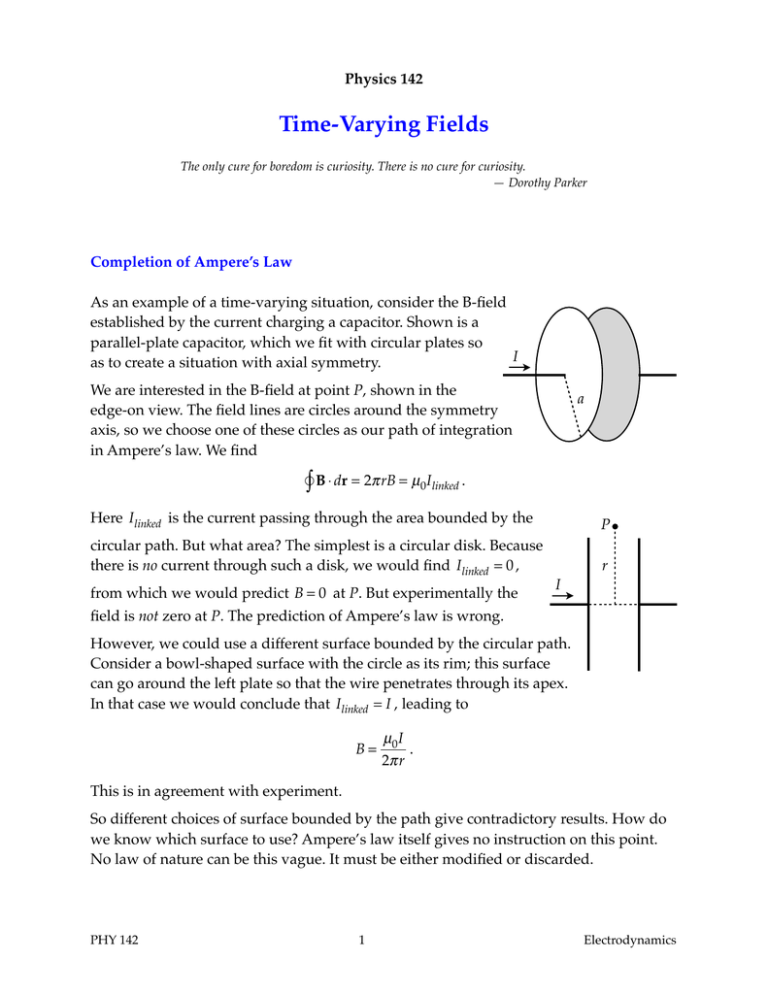
Physics 142 Time-Varying Fields The only cure for boredom is curiosity. There is no cure for curiosity. — Dorothy Parker Completion of Ampere’s Law As an example of a time-varying situation, consider the B-field established by the current charging a capacitor. Shown is a parallel-plate capacitor, which we fit with circular plates so I as to create a situation with axial symmetry. We are interested in the B-field at point P, shown in the edge-on view. The field lines are circles around the symmetry axis, so we choose one of these circles as our path of integration in Ampere’s law. We find a ∫ B ⋅ dr = 2π rB = µ0Ilinked . Here I linked is the current passing through the area bounded by the P circular path. But what area? The simplest is a circular disk. Because there is no current through such a disk, we would find I linked = 0 , r from which we would predict B = 0 at P. But experimentally the field is not zero at P. The prediction of Ampere’s law is wrong. I However, we could use a different surface bounded by the circular path. Consider a bowl-shaped surface with the circle as its rim; this surface can go around the left plate so that the wire penetrates through its apex. In that case we would conclude that I linked = I , leading to B= µ0 I . 2π r This is in agreement with experiment. So different choices of surface bounded by the path give contradictory results. How do we know which surface to use? Ampere’s law itself gives no instruction on this point. No law of nature can be this vague. It must be either modified or discarded. PHY 142! 1! Electrodynamics Now consider the flux of the E-field through these two surfaces bounded by the circle. First use the circular disk surface. Outside the region between the plates the E-field is negligible, so the flux of E through the disk surface is that through a circle of radius a: Φe = ∫ E ⋅dA = π a2E = π a2 Q ε 0π a 2 = Q . ε0 (Here we have used E = σ / ε 0 and σ = Q/ π a2 .) From this we find ε0 dΦe dQ = = I. dt dt This shows that the quantity ε 0 ⋅ dΦe /dt has the dimensions of a current, which in this case is the same as the current in the wires. Maxwell called it the displacement current. The term “displacement” arose from a model Maxwell had in mind, and has no significance today. He suggested that Ampere’s law must be completed by adding the displacement current to the “true” current, so that the law reads ⎡ d ⎤ ∫ B ⋅ dr = µ0 ⎢⎣ Ilinked + ε0 dt ∫ E ⋅ dA ⎥⎦ . Now let us apply this to our capacitor situation to see how it resolves the ambiguity. If µ I d we choose the disk surface, then I linked = 0 but ε 0 ∫ E ⋅ dA = I ,so we find B = 0 , as dt 2π r we should. If we choose the bowl surface we have I linked = I and (because the E-field is zero on this surface) ε 0 µ I d E ⋅ dA = 0 , again leading to B = 0 . The choice of surface ∫ dt 2π r no longer matters. We write the new law, using the current density j to represent the “true” current: ⎡ ∂E ⎤ ∫ B ⋅ dr = µ0 ∫ ⎢⎣ j + ε0 ∂t ⎥⎦ ⋅ dA Ampere-Maxwell law Because ε 0 is so small (of order 10−11 in SI units), the “displacement” term is usually negligible compared to the “true” term in ordinary circuits. But in empty space, where there is no “true” current, the displacement current is the only source of B-fields; this is crucial for the existence of electromagnetic waves. In any case, we have found a remarkable new aspect of electromagnetism: ! A time-varying electric field creates a magnetic field. Next we will see that the converse is also true. PHY 142! 2! Electrodynamics Motional emf If a conductor is moved through a B-field, the charges in the conductor experience the magnetic force F = v × B . This force causes the conduction charges (which can move freely) to move until their separation from the positive ions of the material produces an electric field, giving an electric force to balance the magnetic force. The charges then come to rest relative to the conductor. This separation of charges within the conductor by the magnetic force has the same effect as the chemical forces that separate charges in a battery. In other words, motion of the conductor through the B-field creates an emf. The work done on these charges to separate them is not done by the B-field, since that field never does any work on point charges. It is done indirectly by the agent that moves the conductor through the field. In the situation shown from above, a conducting wire is being pulled to the right at speed v, sliding on parallel smooth conducting rails. The rails are R connected at their left end by a resistor, forming a complete circuit. The wire moves through a B-field, which we will assume is uniform and into the page. The magnetic force on a positive charge in the sliding wire has magnitude F = qvB and is directed up the wire. As this B ⊗ v d x charge moves along the length of the wire, work W = qvB ⋅ d is done on it. Since the work per unit charge is the emf, we have E = vBd . In the closed circuit this emf plays the same role as a battery, producing a current I = E /R = vBd /R . We say that the motion of the wire “induces” an emf, which causes an “induced” current to flow in the circuit. This is a case of electromagnetic induction. Where does the energy come from? Consider the force exerted on the current-carrying wire by the B-field. It has magnitude Fm = IBd , and is directed to the left in the figure. This opposes the motion of the wire, so to keep the wire moving through the B-field an external agent must exert a force (to the right) of this magnitude. The work done by this agent supplies the energy to the circuit. The “motional” emf produced by a moving conductor in a magnetic field is the basic principle of electric generators. The discovery of this principle was one of the most important technological advances in history, making it relatively easy to convert mechanical energy into electrical energy which can be transmitted over large distances. PHY 142! 3! Electrodynamics Is there anything new here? It seems that we have introduced no new principles in this analysis of motional emf. The force that the B-field provides is the familiar Lorentz force. But consider how things look in a reference frame attached to the moving wire. (If it moves with constant velocity, this is also an inertial frame.) In this frame the charges are initially at rest and it is the sources of the B-field that are moving. Since a B-field exerts no force on a charge at rest, what is it that pushes the charges up the wire? If there is a force proportional to the charge, acting on a charge at rest, there is an electric field — by definition. In the frame moving with the wire, there exists an E-field in the wire, in the upward direction. What is the source of this E-field? It is the changing magnetic situation caused by the fact that the sources of the B-field are in motion. To analyze in detail how the fields change when one goes to a different inertial frame, we would need the theory of special relativity, which is beyond the scope of this discussion. But from this case we see that what in one frame is a static B-field with no Efield becomes in another frame a combination of both E- and B-fields. Electric and magnetic fields are interconnected in a deep and fundamental way, and are really two different aspects of the same thing. That thing is called the electromagnetic field. Faraday's law Return to the reference frame in which the rails are at rest and the wire is moving. We found that the induced emf is E = vBd . Now the area of the rectangular region bounded by the circuit in which the current flows is A = xd . The magnetic flux through that area is Φm = BA = Bxd . Since the speed of the wire is v = dx /dt we see that dΦ m / dt = vBd , which we found to be the emf. So the emf is equal (in magnitude) to dΦm /dt . Is this a coincidence peculiar to the particular situation described here? Suppose all the wires are fixed but the B-field changes with time. Then there will be a change in Φm but no moving conductors. Will there be an induced emf in this case, and will its magnitude be equal to dΦm /dt ? Experiments by Faraday and others showed that indeed there is an induced emf of magnitude dΦm /dt , regardless of why the magnetic flux changes. These experiments are summarized in a new fundamental law, which for emfs in circuits takes the form called the Flux Rule: E=− Flux rule (Faraday’s law) PHY 142! 4! dΦm dt Electrodynamics The negative sign denoting the direction of the induced emf has a name of its own: Lenz’s law An induced current creates a B-field whose flux opposes the change in flux that caused the current. Take the loop with the moving wire as an example. The magnetic flux into the page is increasing as the wire moves (because the area increases). The induced emf causes a counter-clockwise induced current; this creates a new B-field out of the page, thus opposing the flux increase. If the wire had been moving to the left (decreasing the flux into the page) the induced emf and current would have been clockwise, creating a new Bfield into the page, opposing the decrease in flux. This “negative feedback” situation is in fact compelled by conservation of energy. If it were the other way around, one could easily make runaway currents in circuits, which would amount to creation of energy from nothing. Faraday's law as a field equation In cases where the changing magnetic flux is due to a changing B-field rather than a moving conductor, the induced emf is attributable to an induced E-field. This shows that: ! A time-varying B-field creates an E-field. But this E-field can do a net amount of work on the charges in a closed circuit, so its line integral around the closed path of the circuit is not zero. This violates one of the main properties of the electrostatic field. The induced E-field is not a conservative field, and there is no scalar potential field associated with it. In fact, the induced emf is just the line integral of E, because it represents the net work done per unit charge by the induced E-field: E= ∫ E ⋅ dr . According to the flux rule, this is minus the rate of change of the magnetic flux through the area bounded by the path of integration. If the bounding path is fixed we can write dΦm ∂B =∫ ⋅dA . dt ∂t The flux rule then becomes a fundamental relation between the fields: ∂B ∫ E ⋅ dr = − ∫ ∂t ⋅ dA Faraday’s law (field equation) PHY 142! 5! Electrodynamics This contains the flux rule, but it implies much more. It predicts that any changing magnetic field will serve as the source of an electric field. Combining this with the Ampere-Maxwell law, we see a remarkable connection between the fields: A time-varying field of one type anywhere produces a field of the other type everywhere. Historically Faraday’s discovery came 30 years before Maxwell’s work and indeed inspired it. Faraday was probably the greatest experimental physicist ever, and Maxwell was one of the greatest theorists. The equations of electromagnetism Faraday's law completes the set of equations describing the electromagnetic field. These four equations are among the pillars of classical physics. ε 0 ∫ E ⋅ dA = Qenc ∂B ∫ E ⋅ dr = − ∫ ∂t ⋅ dA Maxwell’s equations ∫ B ⋅ dA = 0 ⎡ ∂E ⎤ ∫ B ⋅ dr = µ0 ∫ ⎢⎣ j + ε0 ∂t ⎥⎦ ⋅ dA To complete the description, we add the Lorentz force: F = q(E + v × B) Lorentz force The theory embodied in these five equations ranks with conservation of energy and the theory of evolution among the supreme scientific discoveries of the 19th century. It is hard to overstate the practical importance of this accomplishment. All of the everyday things in our lives that make use of electromagnetism are based on these equations, as are the light waves that allow us to experience the world around us with our eyes. Induced fields The terms on the right sides in Maxwell's equations describe the sources of the fields that appear on the left sides. We see that an E-field can be produced either by charges or by changing B-fields, while a B-field can be produced either by currents or by changing E-fields. Fields created by changing fields of the other type are called induced fields. There is an important difference between the fields produced by these different types of sources. Those created by charges or currents fall off with distance from the source at least as fast as the inverse square. (Recall Coulomb's law and the Biot-Savart law.) PHY 142! 6! Electrodynamics Because of this relatively rapid decrease with distance, these are sometimes called "near" fields, and they are usually dominant near the sources. B-fields are also produced by intrinsic magnetic moments of particles such as electrons and nuclei; these sources are responsible for phenomena, such as properties of permanent magnets, which we do not discuss in this course. These fields fall off with distance at least as fast as the inverse cube. The induced fields, on the other hand, fall off with distance only as the inverse first power. They persist to greater distances, and are often called the "far" fields. Near the sources the fields due to charges and currents are frequently much stronger than the induced fields, but far from the sources the induced fields dominate. As we will see, it is the induced fields that are capable of carrying energy from the sources to great distances, in the form of electromagnetic radiation. As an example of an induced field, consider a solenoid in which the current changes with time. Shown is a cross section, looking along the axis of the solenoid. As an approximation we assume the B-field is uniform and entirely confined to the interior of the solenoid, into the page as shown. We are interested in the E-field at a point P outside the solenoid. The source for this Efield is the solenoid’s changing B-field. We use Faraday's law. B ⊗ r •P R By the symmetry, the lines of the induced E-field (which are always closed curves) must be circles. We choose the dotted circle passing through the field point P as our path of integration. Let the B-field be increasing. If there were a wire loop at the location of the dotted circle, then by Lenz's law the induced emf would be counter-clockwise, creating a current which would produce a field (out of the page) opposing the increase in the solenoid field. The actual cause of this current is the induced E-field, which runs counterclockwise. We will integrate that way around the circle. By symmetry, the magnitude of E is the same at all points on the circle. The left side of Faraday's law thus becomes simply ∫ E ⋅ dr = 2π rE . The magnetic flux on the right side is B times the area of the solenoid π R 2 , since there is magnetic flux only within the solenoid. Faraday's law then says that 2π rE = π R 2 dB dt from which we find R 2 dB E= . 2r dt PHY 142! 7! Electrodynamics Note that this induced E-field falls off with distance from its source (the region of the changing B-field) as 1/r. A similar result holds for the B-field created by the changing E-field between the capacitor plates discussed earlier in connection with the displacement current. As we found in that case, the induced B-field falls off with distance as 1/r and, like all B-fields, has field lines forming closed curves. Similar analyses can be carried out to find the induced E-field inside the solenoid, or the induced B-field in the region between the capacitor plates. These will be left for the assignments. To summarize: • Induced E (or B) fields are created by B (or E) fields that change with time. • Induced field lines always form closed curves. • Induced field strengths fall off with distance from the source as 1/r. We will see later that electromagnetic waves consist entirely of induced E- and B-fields, propagating through space by creating each other. PHY 142! 8! Electrodynamics

